When You Want A Little Gaming: The AVADirect Nano Gaming Cube
by Dustin Sklavos on September 16, 2010 10:55 PM ESTExactly How Much Power You Can Fit in a Mini-ITX Case?
If the benchmarks on this page look familiar, it's because they're essentially the same charts we used for the review of the CyberPower Xtreme Gamer 8500. In this instance we're highlighting the performance of the AVADirect Nano Gaming Cube. It's a good opportunity to bring up an important consideration here: while the processor in the cube has been overclocked to 3GHz, it's still a quad-core i5 without Hyper-Threading, and oh yeah, it's being handled by a server processor cooler. The cube is substantially daintier than the competition, and expectations should be attenuated. We'll start with the basic system-based benchmarks.
Update: We've added our own "custom built" PC to the benchmarks as another point of reference. That system consists of an i7-920 cooled by a Noctua NH-U12DX HSF with push-pull NF-P12 fans, Gigabyte X58A-UD3R, 6x2GB Crucial DDR3-1600, and CrossFire HD 5850 GPUs, all running off an Enermax Pro87+ 500W PSU. The storage setup is overkill for most: a 120GB OCZ Vertex 2 SSD with a SandForce controller for the OS, and an older OCZ Vertex 128GB SSD. All of this is housed in a stylish Lian Li PC-7B case. Total cost? Pricing out the components on Newegg gets us to just $2300, including the OS (though the two SSDs account for $525, and there's $60 in mail-in rebates available. But there's a catch: the CPU is an old engineering sample that's locked down so tight that overclocking is out of the question. Change the uncore multiplier or raise the BCLK more than 4MHz and the system refuses to POST. Ouch! So this is a super overkill setup intended for overclocking but in need of a different CPU. Not surprisingly, the CPU is clearly holding it back in quite a few tests, and the other components should allow for a healthy overclock; anyway, it's one more system to add to our benchmarks, and it serves as an interesting look at what happens with a stock i7 CPU.
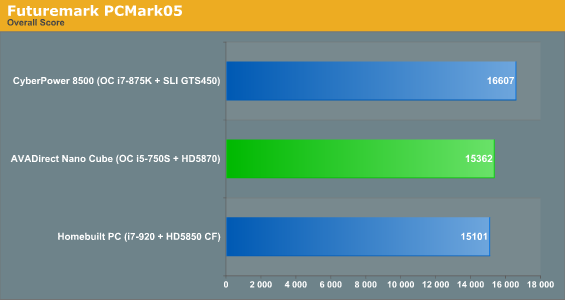
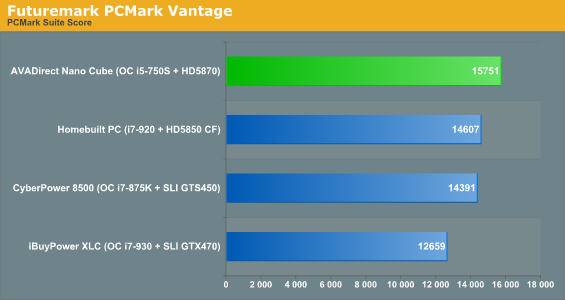
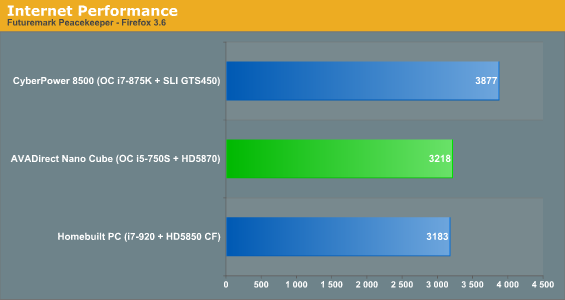

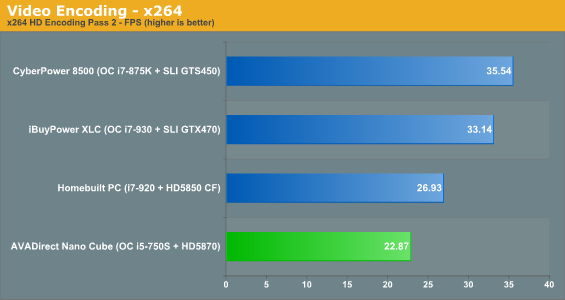

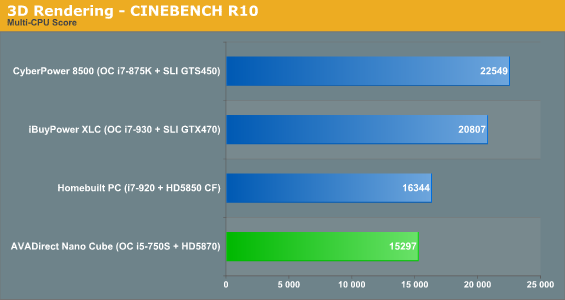
It's fair to say the multi-threaded benchmarks aren't particularly kind to the cube, but also understand that the 750S is running at a still-reasonable 3GHz and doesn't benefit from Hyper-Threading like the i7's do. These numbers are still comparable to the numbers on the Dell Studio XPS 7100 we reviewed, a machine that had the benefit of a full two additional physical cores and a higher TDP. At this point it's worth adding that the iBuyPower Paladin XLC is running at a 3.5GHz overclock on its i7-930, and the CyberPower Xtreme Gamer 8500 has a punishing 3.85GHz overclock on its i7-875K. The competition's fast to begin with.
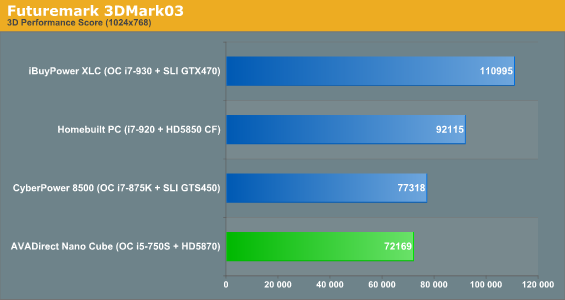

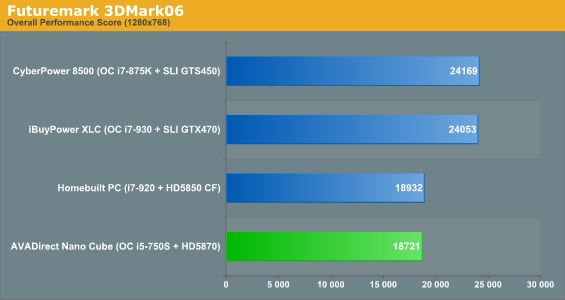
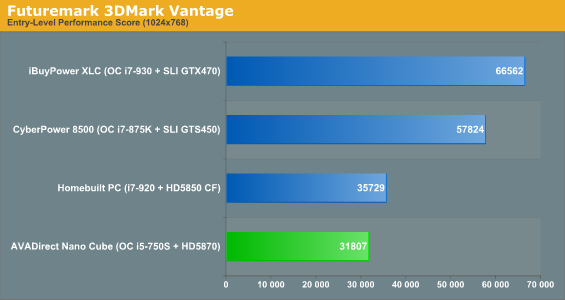
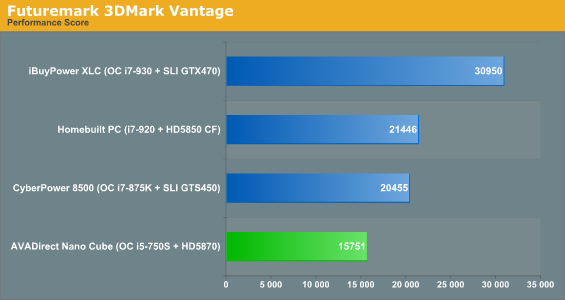
Unfortunately, performance suffers in every case from the 3GHz clock on the i5. Under ideal circumstances and an even playing field, the GeForce GTS 450's in SLI would be nipping at the heels of the AMD Radeon HD 5870 in the nano cube, but with the substantially faster core clock on the i7-875K (benefitting also from enough space for a watercooling kit), the cube just can't keep up. Having said that, these numbers are still pretty impressive given the tiny footprint of the machine producing them.










42 Comments
View All Comments
MeTechE - Thursday, September 16, 2010 - link
Perhaps you would be interested in my current computer as a powerful Mini-ITX setup done right. I have a OC'd i7 785K with 2x4GB of ~1400MHz DDR3 on a H55N-USB3. The ATI Radeon 5770 is perhaps underpowered compared to the rest of the build but it fit the budget.Most surprising was the 16K/14K/19K Read/Write/Copy performance I got from the RAM http://imgur.com/fEjj3.png . That bandwidth along with the CPU OC allows my rig to bench competitively with my friends 4Ghz i7 920.
Don't let one bad configuration spoil the Mini-ITX fun.
mados123 - Saturday, September 18, 2010 - link
What case is that in?Huacanacha - Saturday, September 18, 2010 - link
I'm planning to build a very similar mini-ITX gaming machine for about the same budget:- Lian-Li PC-Q08 case
- Core i5-760
- Gigabyte or Zotac MB (GB has USB 3.0, Zotac USB 3.0 + wifi)
- Intel 160GB SSD + 1TB green HD
- ATI 5850/5770 (actually waiting to see if 6770 comes out this year)
- 4GB DDR3
- Slim DVD (may drop as don't need)
- 500W modular PSU
- Windows 7 Home Premium
Total is about $1500. The case is much nicer looking than the Sugo and should be better for noise & heat, but then again it's also a fair chunk larger I believe. I think I'll take my proposed build over the AVADirect one, but it's nice to see custom built SFF gaming PC's starting to appear... I'm all for the bang-for-cm^3 concept!
This will be hooked up my living room TV, and probably mainly used for playing Civ 5 :)
anactoraaron - Friday, September 17, 2010 - link
"Meanwhile the pair of GTX 470's in the iBuyPower Paladin XLC blows everything away, much like the leafblower it sounds like under this kind of load." Looking at graphs makes some forget this 'noise' produced by the first fermi. The noise reminds me of a case fan I had on a heavily oc'd P4 that went by the name of 'tornado'. At the time I lived in an apartment and that fan was so loud the downstairs neighbor complained about the noise LOL! Noise yes, but man that thing could move some air (which one needed to do sometimes with stock P4's).Von Matrices - Friday, September 17, 2010 - link
I have a GTX 470 SLI system, and while the cards are definitely louder than any previous cards I have had, I wouldn't exactly compare their sound to a leaf blower. Granted I'm using the proper spacing of the cards (2 empty slots between them), but they only make a low-pitched rumble when at load. I'd much rather have the noise of two 470's than the whine of the 60mm fan on the Radeon 9800 Pro I had a few systems ago. That fan was just plain annoying.Kibbles - Friday, September 17, 2010 - link
I have almost the same setup except with a 5770 and I run 160blk with no voltage increases and with turbo and c-states still enabled. It wasn't even much work.I just went
166 -> unstable
165 -> stable-ish
164-> runs fine
back off a couple just to be safe -> 160
Probably took me but a whole 30mins.
I expect more from a system that's $1.5k+, since mine was under $700.
I guess you do get a 750S vs regular 750.
What kind of core temperatures where you getting?
vol7ron - Friday, September 17, 2010 - link
I agree, price looks high for what you get.I think your OCing is a bit discouraged, though. Even though there are failsafes these days, it's still advised to go from what works to what doesn't, when figuring out the proper setting; rather than going from what doesn't work, to what does.
Kibbles - Friday, September 17, 2010 - link
TrueIf I was starting from scratch, I'd go up 5mhz at a time, and then ease back for longterm stability. But in my case I knew from reading around, the ballpark where the OC should be at. So I skipped that first step. Plus, I wasn't altering any of the voltages. For a builder that's going to be making a bunch of these, I would think they could do that too.
sprockkets - Friday, September 17, 2010 - link
They took this case and modded it:http://www.newegg.com/Product/Product.aspx?Item=N8...
Sad. They took out the 300w 80PLUS FSP power supply and put in an junky Athena.
And btw, the new SFF Shuttles can be upgraded with mini itx boards, such as this one:
http://global.shuttle.com/product_detail.jsp?PLLI=...
JarredWalton - Friday, September 17, 2010 - link
Which is why I said the "old Shuttle SFFs". That said, my experience over the past five years is such that I would never buy anything with a Shuttle mobo. Every one of the test Shuttle SFFs died within three years of the review. :-\